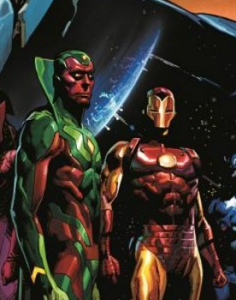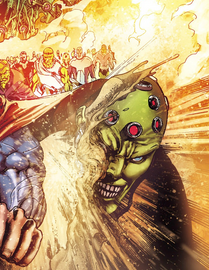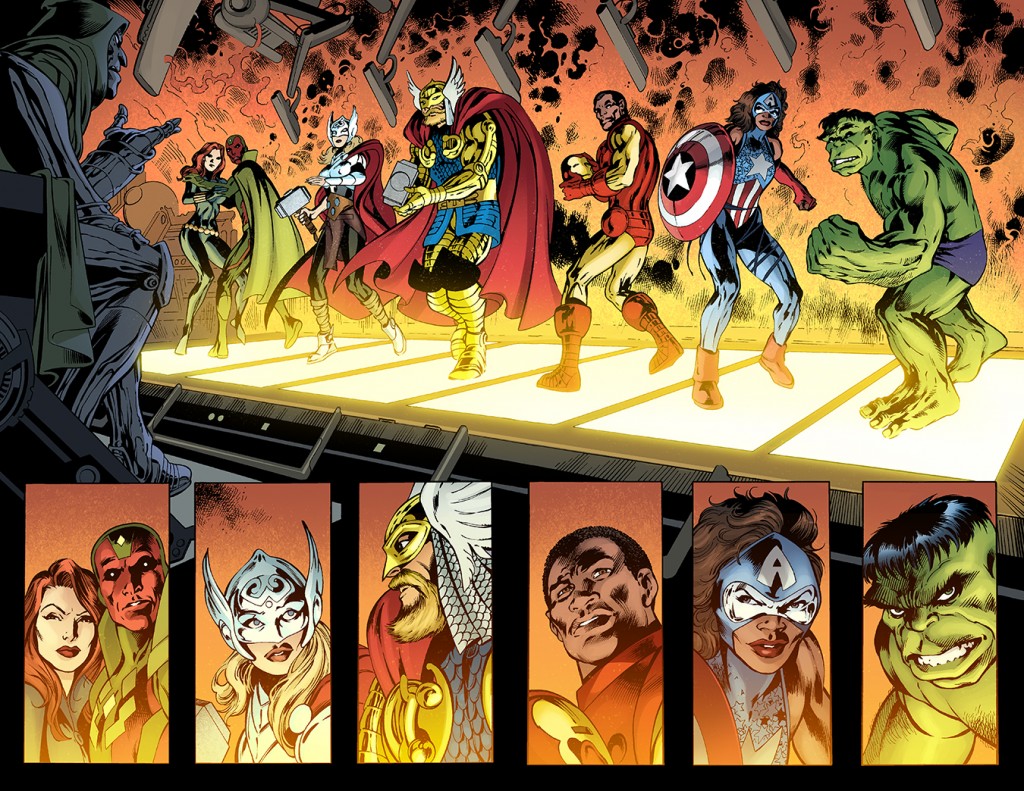Deadshirt Is Reading… is a weekly feature in which Deadshirt’s staff, contributing writers, and friends-of-the-site offer their thoughts on Big Two cape titles, creator-owned books, webcomics and more. For more of our thoughts on this week’s new comics, take a look at Wednesday’s Deadshirt Comics Shopping List.
David Uzumeri is reading…
Written by Rick Remender
Art by Jerome Opeña and Pepe Larraz
Additional Inks by Mark Morales
Colored by Dean White, Rachelle Rosenberg and Dono Sanchez Almara
Lettered by Clayton Cowles
Marvel
“I didn’t kill them — I turned them off.”
Marvel’s reborn Original Graphic Novel line has been an odd duck ever since it was reintroduced with Warren Ellis and Mike McKone’s Avengers: Endless Wartime two years ago. That story was a largely self-contained Avengers romp, and for the most part, its successors have followed, telling in-continuity yet largely self-contained stories anchored by high-quality creative teams, with the notable quirk of Jim Starlin’s Thanos series, which, while in continuity, are pretty much Jim Starlin doing Jim Starlin Cosmic like he never left Marvel. These books have nodded at the rest of the Marvel Universe, but so far, the Marvel Universe hasn’t much nodded at them.
So it’s a big surprise, and weirdly unpromoted by Marvel, that Avengers: Rage of Ultron is a Big Deal for the Marvel Universe. It is not, as all the preview art suggested, a flashback story about Hank Pym and Ultron (although it is that in part), nor is it a side story set in current Avengers continuity. In fact, a bunch of details in this suggest it’s actually in Marvel’s future, post-Secret Wars, featuring an Avengers including Sam Wilson Cap, the new Thor and the reformed, post-Axis Sabretooth — and it has some major status quo changes for its starring characters, namely Pym and Ultron, that simply don’t jive with the possibility of taking place during Time Runs Out. In other words: this is a big Avengers storyline, almost event-level, and should be treated accordingly.
Rage of Ultron is a Rick Remender Marvel Universe comic through and through, building on a bunch of his previous stories and themes — the Descendants and Hank Pym’s characterization from his Secret Avengers run, the Stark Sentinels, Sabretooth, Quicksilver and Scarlet Witch from Axis, the conflict between Sam Wilson and Steve Rogers’s styles from All-New Captain America — and bringing a number of them to a fairly thrilling climax. Make no mistake, at its core, this is a family drama of fathers and sons across three generations: Hank Pym, Ultron and the Vision. Beyond all the nanoclouds and decimated cities and planets with gigantic Jack-o-Lantern faces, it comes back to one of those central Rick Remender themes that’s threaded through all of his work from Fear Agent to Franken-Castle to this: just how much fathers can fuck up their sons, and how sons can overcome the legacies given to them by their fucked-up fathers.
It’s a pretty raw, emotional story — the rawest story Remender’s told in the MU in some time, to be honest — that’s simultaneously weirdly hopeful and incredibly mean. People are gonna have Serious Issues with how certain characters are portrayed in this, and while I suspect the fact that it’s an OGN will lead to a somewhat delayed reaction, people are gonna flip a bit as word gets out. Whether or not this book is true to the characters, I can’t really fully judge, but I can say that it’s incredibly true to Rick Remender.
Artistically, it’s shockingly consistent for a book with two pencillers, a back-up inker, and three colorists, especially considering that Opeña and Larraz have incredibly different styles. The former’s loose, detailed, and at times (in a considered and intentional way) ugly; the latter’s usually way tighter, with a more stylistic and less realistic bent. You can tell where they switch most of the time, but it’s nowhere near as jarring as it by all rights should be, and for that a huge amount of credit has to be given to the colorists. Dean White is Opeña’s longtime collaborator and one of the best in the business, but Rosenberg and Almara do an excellent job of mimicking his otherworldly, painterly approach, bringing an unexpected visual continuity to the entire enterprise. As for the overall style of art—I mean, it’s Opeña and White; you saw them in Uncanny X-Force and the first arc of Avengers; you know what you’re getting here and how they work with Remender, and that’s “insanely well.” They’ve got assists, but at heart, these are the peeps who brought you the Dark Angel Saga, and they’re bringing it here too. You might hate what this story does, but I can’t imagine being unmoved by the way it’s told.
Sarah Register is reading…
Main story:
Written by Charles Soule
Art by Steve McNiven (pencils) and Jay Leisten (inks)
Color by Justin Ponsor
Letters by Clayton Cowles
Substory:
Written by Ryan Stegman
Art by Ryan Lee
Colored by James Campbell
Lettered by Clayton Cowles
“What now, Inhuman king? Do we battle at the edge of the end of everything?”
Uncanny Inhumans #0 is a whopping issue with two separate stories that lay the foundation for what’s to come, and in this case, what’s to come is the death of the universe. Since the launch of Inhuman, Attilan’s king has only popped up a few times as he deals with his own agenda on the periphery. However, in this zero issue, we get a Black Bolt-centered story in which he teleports back in time a century to find his son, Ahura, and Kang the Conqueror casually throws out the term “TIMEDEATH” (which I can’t help but type in all caps), implying that there is no future for this particular timeline. This is surely tied to incursions and the Secret Wars event, but I’m still just really stuck on how terrifying TIMEDEATH sounds.
I enjoyed Steve McNiven’s work on Black Bolt in this issue, because if there’s one thing McNiven excels at, it’s intense close-ups on faces that are sternly emoting. There’s still plenty of dynamic action panels, however, as the usually silent king is feeling pretty chatty and devastates an entire fortress with a single, tiny-texted word. I’ve always had a soft spot for Blackagar Boltagon and the weird, semi-incestual royal family of the Inhumans, because they’ve remained remarkably unchanged since their first appearance, and McNiven was especially successful making Black Bolt’s winged costume (which, come on, is timeless) and tuning fork head piece particularly menacing as he lurks in the shadows while Kang talks about the end of the world.
One of the ways Marvel has modernized the Inhumans, however, is by introducing a gaggle of diverse teens into the mix. In the secondary story, Nuhumans Flint and Iso bond over their disfiguring new powers as they play with portals. I would be tempted to call this a filler story, except that through the portal we catch a glimpse of a character that, to my knowledge, has only officially been introduced in the Marvel Cinematic Universe (unless he’s later revealed to be an existing character). Many people have mixed emotions with the way the MCU has been bleeding over into Marvel comics, but maybe this is just because we’re so used to it happening the other way around. I’m sure that all those rumors about Marvel pushing the Inhumans due to the MCU not owning rights to the X-Men will continue to not be quelled by this development, nor by this new series’ “Uncanny” title.
I’m excited to watch Marvel’s other first family become relevant again, though hopefully the ongoing story won’t be dictated too much by what plays out on screen in the next few years. This zero issue has some intriguing set up, not only with the TIMEDEATH future (or lack thereof), but also with the Inhuman royal family getting a new super-powered edition. I’ve become invested in all these lovable Nuhumans, so I hope they continue to play a large part as this series blossoms.
Jason Urbanciz is reading…
Written by Dan Jurgens and Jeff King
Art by Ethan Van Sciver
Colored by Marcelo Maiolo
Lettered by Travis Lanham
DC Comics
“I am always intrigued by by those who triumph over death.”
In the aftermath of “Superman: Doomed”, Brainiac has thrown Superman into a pocket universe inhabited by a planet that is the resting place of cities that Brainiacs of the Multiverse have stolen away from their doomed Earths. So for 30-some pages we get a gaggle of Brainiacs walking around with Superman and explaining this to him while he gets confused, then mad, then confused again. That’s basically what the reader feels as well. It’s obvious there’s some kind of Main Brainiac here that wants some information from Superman, and maybe he gets it? I don’t know.
This issue mostly exists to set up the 20 or so Convergence mini-series that will feature these lost cities battling each other for their right to exist on a new Earth that Brainiac will Frankenstein out of them. There seems to be some kind of threat out there that Brainiac is also afraid of? Maybe it’s The Gentry from Multiversity? I doubt it because that would require DC proper to acknowledge that series. I don’t think the setup here is a terrible idea, it’s just that this comic takes so long to explain it. Despite the comic’s $5 price tag, it only holds a dollar’s worth of story.
Ethan Van Sciver handles the art and it’s good, even very good, but the story just gives him so little to draw. He gets to draw a bunch of different Metropolis skylines, and while it’s nice to see nods to various alternate-Earths, mostly it’s just a gang of cross-era Brainiacs and New 52 Superman with 5 o’clock shadow looking dumb. Van Sciver excels at superhero fight comics, and here they’ve given him 30 pages of exposition and, while he does it well, it doesn’t play to his strengths.
Convergence is a weird blip in DC’s publishing schedule, and I’m hoping they’ll be able to break out of this rather dull beginning and have some fun with the main event. While I’m still excited for some of the mini-series that are coming, I’ll be avoiding the main series from here on out.
Jason Urbanciz and Joe Stando are reading…
Avengers: Ultron Forever #1
Written by Al Ewing
Art by Alan Davis (pencils) and Mark Farmer (inks)
Colored by Rachelle Rosenberg
Lettered by VC’s Travis Lanham
Marvel
“God bless Ultron-America.”
Jason: With a new Avengers movie featuring Ultron hitting the theaters in a month, Marvel has begun pushing out Ultron-related product to sate what they hope to be Ultron-hungry crowds of consumers. On the head of this wave is Al Ewing and Alan Davis’s Ultron Forever, a spiritual successor/copycat of Kurt Busiek & Carlos Pacheo’s Avengers Forever. In that mini series, Immortus pulled a team of Avengers from various points in the timestream to battle Kang. This time around, it’s Doctor Doom pulling Avengers to battle Ultron in the far future where he’s taken over not only the world, but the galaxy, leaving only a few thousand free humans left to survive. It’s a fun team he’s assembled, including a future Captain America (who is Luke Cage and Jessica Jones’s daughter), two Thors (the current Lady Thor and the early nineties golden armor variant), Jim Rhodes Iron Man, a Hulk, and current-era Black Widow and The Vision. The book is fun, gets its set-up out of the way quick and moves to the team splitting up to attack some of Ultron’s fortresses, to little success. The fun of the time travel scenario is that it allows Ewing to make anyone expendable (since these things can be easily undone). It both ups the stakes for the book, since anyone can die, but also lowers them since you know they’ll all be back at the end. Alan Davis (and long-time inker Mark Farmer) do the heavy lifting, drawing a cool team of cross-time Avengers fighting their Ultronified former teammates, along with armies of Ultron drones. His bright, elastic art is perfect for the big superhero action Ewing writes for this book. What do you think Joe?
Joe: This book was like catnip for me. The time-travel arc of the main Avengers title has been my favorite part of Hickman’s run, and the Ultron future was a clever twist. My one main complaint with Hickman’s work is that it often focuses so closely on large scale machinations that individual character beats get lost. Ewing’s work on Mighty Avengers is a great counterbalance, so I’m overjoyed that he got to take a swing at some of these concepts. The return of self-loathing Ultron Captain America was a delight, and Davis’ art lends a more classic feel to the story, which is appropriate considering how much it pulls from both recent and older eras of Marvel’s history. Even with a fair number of deaths, it’s a pretty light, bombastic story, and kind of reminds me of a better-executed Age of Ultron.
Jason: I haven’t been reading Hickman’s Avengers, so I had no idea this was actually plugged in to what he was doing, and really it works perfectly on its own. I like seeing these characters interact, and I love that Old-School Thor, seeing that future-Thor is a woman, is all, “Guess I’m dead, you and Mjölnir make a nice couple.” It would be better if Marvel just repackaged this as Age Of Ultron and kicked the previous version under the bed like it never happened. That one is a mess and this is so well done. Interested to see the reveal on Doom, since Vision basically did the worst *wink* “Sure you’re Doom.” Subtlety isn’t that synthazoid’s strong suit.
Joe: Yeah, it stands perfectly well on its own, and I’ve actually been pitching it to friends as a good book to check out even if they’re not caught up on current Marvel stuff. I’m curious about Doom too, since my initial thought (future version of Vision) was debunked a few pages later. This book is just packed with clever bits, and it maintains Ewing’s efforts towards being both diverse and creative in planning teams. Pulling from very specific moments/eras (pre-Avengers Hulk, the current Thor but from the near future) adds to the tension, and while the long-term impact of this miniseries will probably be small, it’s still a super fun ride.
Thanks for reading about what we’re reading! We’ll be back next week with a slew of suggestions from across the comics spectrum. In the meantime, what are you reading? Tell us in the comments section, on Twitter or on our Facebook Page!






